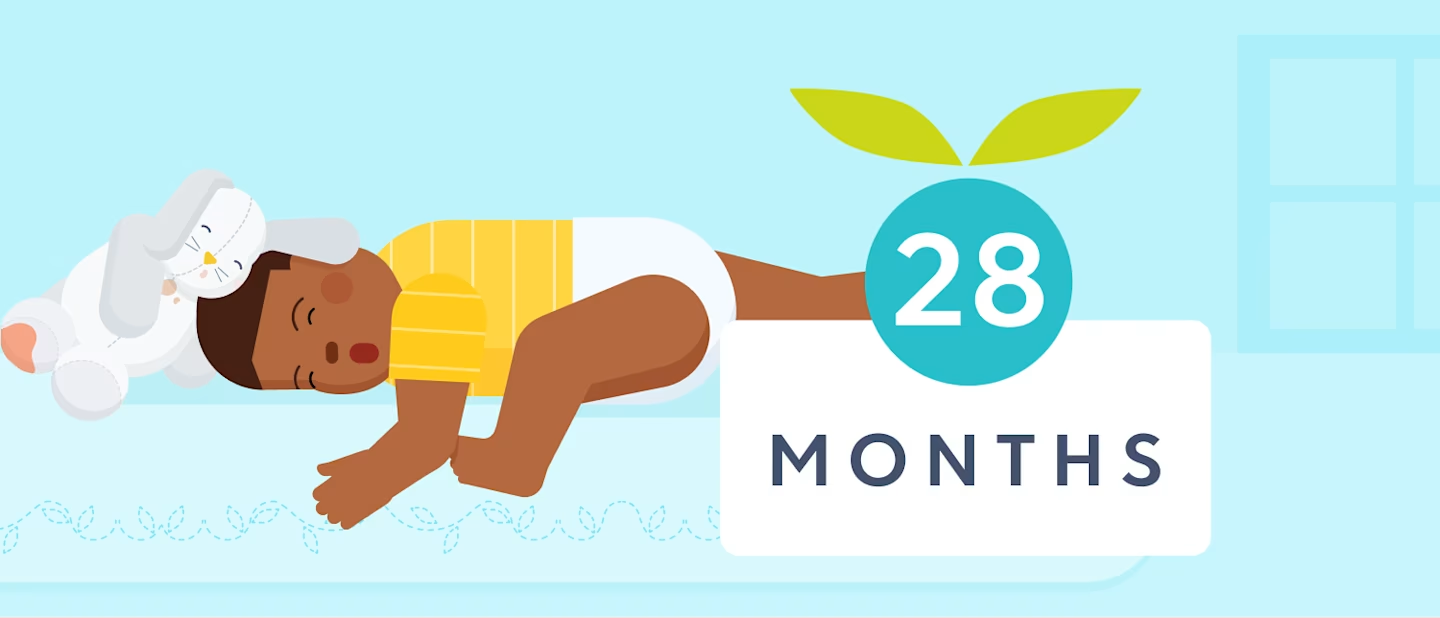28 month old sleep schedule: Bedtime and nap schedule
Updated Dec 15, 2025

At 28 months, your toddler may have been sleeping well then — seemingly out of nowhere — they refuse naps for a week and/or meltdown at bedtime. While frustrating, sleep regressions and tantrums aren’t uncommon at 2. In fact, they’re developmentally appropriate.
In this article, we’ll give you suggestions on what to do during a sleep regression, give you details on how long children typically nap at 28 months, and provide answers to frequently asked questions about toddler sleep.
Editor's note
The recommendations listed below represent the average amount of sleep typically needed at this age. However, please note there is a range of normal as some children have lower or higher sleep needs. Your child’s schedule may vary, and that is normal.
Table of Contents
How much should a 28 month old sleep?
The American Academy of Sleep Medicine recommends 11 - 14 hours [] of total sleep per day for children at 2. This may look like 10 - 11 hours of nighttime sleep and around 1.5 - 2.5 hours of daytime sleep for 28 month olds. However, these ranges are guidelines and it’s OK if your child is sleeping more or less than this. Every child is different and has unique sleep needs.
Here's a quick overview of what you may expect when it comes to 28 month olds and sleep. Note that these figures are averages and should be used as guidelines.
| Average total sleep | 12 hours |
| Number of naps | 1 |
| Goal daytime sleep | 1.5 - 2.5 hours |
| Wake windows | 5.5 - 6 hours |
Top sleep tips for 28 month olds
Contrary to popular belief, sleep regressions don’t occur at prescribed times. They can happen anytime! However, 2 is a common age where we tend to see a , often stemming from all the growth and change children this age experience.
There are lots of factors that may impact sleep at 28 months, including , , and milestones like , moving, and . These things can all lead to a sudden, significant decline in sleep patterns aka a “sleep regression.”
If your little one is experiencing a , there are a few ways we recommend navigating this period of challenging sleep:
Keep up with healthy sleep hygiene habits (like preserving )
Ensure you’re offering a daily nap at an
Be patient! Sometimes kids need a couple of weeks to master a milestone or bounce back from a period of separation anxiety or teething.
Another common challenge we see around 28 months is children waking early due to hunger. We often recommend a later dinner or pre-bedtime snack, as it can be hard for kids to go 12+ hours in between dinner and breakfast.
Editor's note
Most children aren’t ready to completely stop napping at 28 months, even though periods of sleep resistance can be typical at this age. If your child is suddenly going through a nap strike, this may be a sign that they need a slight schedule change. Toddlers tend to do well with around 5.5 hours of awake time before their daily nap, but every child is different. Your little one may need more or less awake time and that’s OK!
Sample 28 month old sleep schedule
| Nap | 12:30 PM - 2:30 PM (2 hour nap); 5.5 hours of awake time before nap |
| Get ready for bed | 7:45 PM |
| Asleep | 8:30 PM; 6 hours of awake time before bedtime |
Note: Sleep needs vary by child, and this chart should be viewed as an example.
Naptime schedule for a 2 year old
Most 28 month olds will continue to , after around 5.5 of awake time in the morning. We recommend offering lunch before the nap to ensure your toddler doesn’t wake from the nap early due to hunger.
How long should a 2 year old nap?
At this age, we typically see a daily nap that lasts around 1.5 - 2 hours. However, all children have different sleep needs and it’s not uncommon for 28 month olds to sleep more or less than this during the day.
However, if naps are very short or long, overnight sleep may be impacted. For instance, children who take short naps during the day may need an earlier bedtime (no earlier than 6:00 PM). On the other hand, kids who take a long (or late) afternoon nap may have a hard time falling asleep at their typical bedtime.
How many naps for a 2 year old?
A is typical for 28 months. Most kids take an afternoon nap after 5.5 - 6 hours of awake time in the morning.
1-nap schedule
| Nap | 12:30 PM - 2:30 PM (2 hour nap); 5.5 hours of awake time before nap |
| Get ready for bed | 7:45 PM |
| Asleep | 8:30 PM; 6 hours of awake time before bedtime |
Note: Sleep needs vary by child and this chart should be viewed as an example.
1-nap schedule with short nap/early bedtime
Consider moving bedtime earlier (but not before 6:00 PM) if your child has taken a short nap or skipped a nap on a particular day. Insufficient daytime sleep can lead to overtiredness, which makes it harder for toddlers to fall asleep and stay asleep.
| Nap | 12:00 PM - 1:30 PM (1.5 hour nap); 5.5 hours of awake time before nap |
| Get ready for bed | 6:45 PM |
| Asleep | 7:30 PM; 6 hours of awake time before bedtime |
Note: Sleep needs vary by child and this chart should be viewed as an example.
Bedtime for 28 month olds
are a frustrating yet normal part of toddlerhood. Stalling is common and can signal a need for a schedule change as toddlers often need more time to wind down before bed. It's normal and appropriate to need a longer bedtime routine (~45 minutes) in dim lighting in order to fall asleep quickly at bedtime. In this case, you could start a longer bedtime routine earlier to maintain their normal bedtime, or push bedtime a little later if it seems as though your child isn’t quite sleepy enough when it’s time to sleep.
We also often see meltdowns around sleep when children are tired and pushing boundaries. If your little one refuses to brush their teeth, throws a fit when you stop reading stories, or cries when it’s time to turn off the lights, you’re not alone. This is typical toddler behavior and rest assured it’s developmentally appropriate [] — and temporary.
In the meantime, there are some ways to minimize bedtime resistance. We suggest setting boundaries so your child feels secure and confident about knowing what to expect. Offering two age-appropriate choices [] (“Do you want to read this book or that one?”) can also give your 28 month old a sense of control.
What time should a 28 month old go to bed?
We recommend aiming for a consistent bedtime that allows for around 6 hours of awake time after your toddler’s afternoon nap. Ideally the nap will be in the middle of the day to help ensure at least 10 - 11 hours of night sleep. For example, if your child typically wakes at 6:30 AM, bedtime will likely be around 7:30 - 8:30 PM. A regular bedtime can help regulate the body’s internal clock, which improves sleep quality and leads to more restful sleep.
You may be wondering how to adjust bedtime when your child’s nap lengths fluctuate a bit. If daytime sleep durations vary, it’s OK to maintain the same bedtime. However, if a nap is skipped entirely, they may have a hard time making it to their regular bedtime without becoming overtired. In this case, consider offering an early bedtime. Note that if bedtime moves before 6:00 PM, this may lead to a cycle of early rising that can be hard to shift later.
On the other hand, if your child’s nap pattern has changed (naps now begin 30 minutes later, for example) you may want to adjust bedtime a little later as well. This can ensure they’re sufficiently tired when it’s time to sleep at night.
In general, we recommend taking into account your child’s overall mood and energy levels in addition to the number of hours they’re sleeping per day when determining if they’re getting enough rest.
Why does my 28 month old keep waking up at night crying?
Toddlers are changing and growing in so many ways around 28 months — physical, emotional, and cognitive. While exciting, these things may also throw a curve ball when it comes to your kiddo's sleep. Common factors contributing to night wakings at this age include:
Seeking independence
Mastering new milestones
A need for a schedule adjustment
Parent-led sleep associations
Discomfort from illness or teething
Travel
Big life changes, like starting daycare or welcoming a new sibling
If you’re looking for more sleep support, consider submitting for a personalized, step-by-step Sleep Plan via .
Is there a sleep regression at 28 months?
It's common to think of , but they can pop up at any age. However, around 28 months you might notice more frequent night wakings, early morning wake-up times, and/or increased resistance to naps. These disruptions are often linked to big developmental changes, growing independence, or changes in routine. While many refer to this as the “,” not every child will go through it.
Can I sleep train a 28 month old?
As kiddos grow, often shifts to match their developmental stage, but the core goal stays the same: helping them learn to fall asleep independently. Instead of methods used with babies, sleep training at this age may focus more on clear routines, age-appropriate expectations, and positive reinforcement. With consistency and support, many children adjust well and sleep improves in both quantity and quality.
Can my 28 month old sleep with a pacifier?
The American Academy of Pediatric Dentistry points out that prolonged pacifier use can impact dental development, but your child’s sleep habits matter too []. At 28 months, many toddlers still rely on a pacifier to fall asleep, and taking it away too soon can lead to nap resistance — or even dropping naps altogether — which may cause new sleep challenges at night.
If your little one is still using a pacifier for sleep, it’s usually best to wait until after age 3 to phase it out. By then, sleep is often more solid, and kiddos are better equipped to manage bedtime without it.
Can a 28 month old sleep on their stomach or side?
By 28 months, it’s generally safe to allow them to fall asleep on their side or stomach if that’s how they naturally settle, as long as your child is able to roll over and adjust their position independently.
What are the developmental milestones for a 28 month old?
At , your little one is probably showing off some fun new skills and saying or doing things that feel brand new! Still, every child grows at their own pace, and it’s normal if your kiddo isn’t doing all the same things as other kids their age. Each child is unique and will reach milestones in their own time — and that’s perfectly OK.
Walks and runs well
Can walk up the stairs with or without assistance
Turns a single page of a book
Holds and crayon and scribbles spontaneously
Stacks 4 blocks by 24 months and 10 blocks by 36 months
Says 200 - 1,000 words by 3 years old
Uses short sentences and phrases
Starting to name body parts and animals
Expresses a range of emotions
Notices when other people are upset or hurt
Says “no!” frequently and has temper tantrums
Engages in parallel play with other children
Enjoys being around kids
Starts to sort shapes and colors
Engages in early make-believe play
Does a 28 month old need to eat during the night?
By 28 months, usually aren’t necessary. With steady bedtime rituals and plenty of daytime nutrition, most toddlers can comfortably sleep through the night and wait until morning to eat. If your little one is waking up hungry, try offering a small bedtime snack — like string cheese or peanut butter with crackers — to help them stay full until breakfast.
Takeaway
Most children will sleep around 11 - 14 hours per day at 28 months. A typical breakdown is 10 - 11 hours of overnight sleep and one afternoon nap.
A 28 month old will likely sleep for 1.5 - 2.5 hours during the day. However, toddlers often go through periods when they resist sleep. They may even stop napping for a time. We recommend continuing to offer a daily nap, even when sleep is bumpy, as most children are not ready to completely give up napping at this age.
Toddlers often need around 5.5 - 6 hours of awake time before their afternoon nap and then another 6 hours of awake time after their nap before bed. However, consider adjusting this schedule as needed when nap patterns change.
If you're curious about what lies ahead in the coming month, glimpse into the future to see what you might experience when your little one is on a . Or take a look back at .
28 month old baby sleep FAQ
Share article:
Note: The content on this site is for informational purposes only and should not replace medical advice from your doctor, pediatrician, or medical professional. If you have questions or concerns, you should contact a medical professional.
3 Sources
Table of Contents
Share article:






